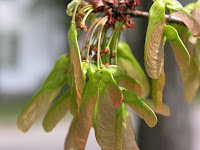Spring is nearly here in Philadelphia. Last week I saw a small forest of snowdrops by Ithan elementary. And just today, I noticed a few silver maple buds had broken on some of the street trees. Soon all the red and silver maples will be lit up with small whorls of yellow-red-brown flowers. Soon the Redbuds will be stopping people in their tracks and soon the Forsythia will be painting wide yellow swaths on the landscape.
I've spent the past month thinking about all the wonderful things I would tell you about winter tree identification. Now that I'm finally getting around to this, it's almost spring. Today I examined a young beach whose buds had swelled and were nothing like the long, thin, elegant buds we see all winter. The red maples are looking fuzzier than ever. Spring is coming quick. Despite that, I'm going to talk about winter ID anyway.
In winter, you ain't got no leaves. Who needs them anyway? Bark color and texture, as well as overall structure, can be very telling. Let's take the ashes for example. In summer, they're a mess of leaves. On a tree that presents like an ash, big and bushy and indistinct, I go right for the bark. But in winter it's so much easier. Ashes have alternate branching and, in winter, that alternate branching can be seen from afar if you look at the tips of the branches. The ends are like pitch-forks and those upper branches are very regular in appearance. No other tree looks like this.
But don't maples also have alternate branching? You bet. But it's not obvious from afar. You really have to look hard to notice it. There is, however, one species of maple that can be easily picked out from the moving car, the Silver Maple. Here again I'm going to want you to look at the tips of the branches, way up in the crown. There you will see ... how to describe it ... all the twigs are covered with visible protrusions. These are the buds, and in Silver Maple, they are red, whorled and extremely prominent, forming dense clusters. Case closed? Well, Red maples can also have bud clusters that look very similar to the Silver Maple. How can you tell the difference? Bark. Any Silver Maple limb over 6" in diameter will have rough bark, while Red Maples have smooth bark on up past 12" diameter. On old trunks, a Silver Maple will often be very shaggy, with strips pealing from one end. Old Red Maples will never have shaggy bark.
So, it's not too late to spot some Ashes and Silver Maples. Look up, at the branch tips. You'll start seeing these common trees everywhere.

The pitch-fork like alternate branching of the Ashes.

The bright red buds of the Silver Maple.

A Silver Maple seen from afar.

The shaggy old bark of a Silver Maple.

The old bark of a Red Maple








